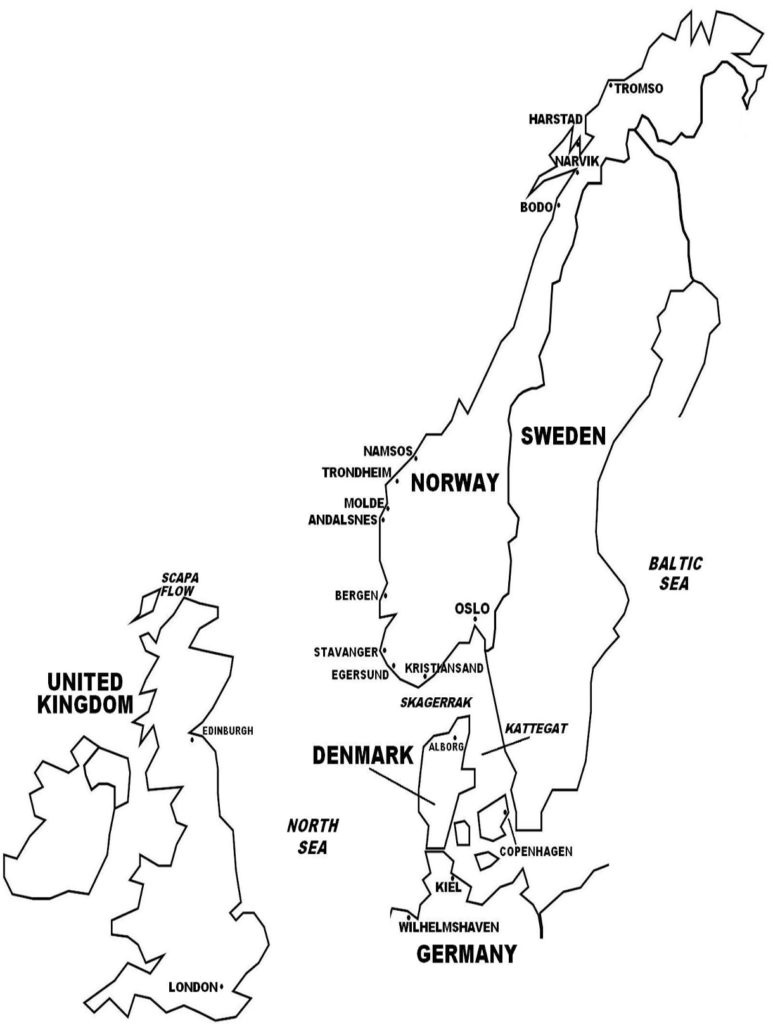On April 14, 1940, Allied transport ships landed the first British troops at Namsos, followed in the next few days by more British units, and on April 19, by French forces. This combined Allied force advanced south toward Steinjker, where it rendezvoused with the Norwegian 5th Division for a joint assault on Trondheim. However, the Germans had gained overwhelming air superiority in the area, which negated any chance of a successful Allied counter-attack. On April 20, the Luftwaffe launched a massive air raid that nearly flattened the town, and more crucially, destroyed most of the Allied supplies needed for the attack. In late April 1940, the Allies abandoned Steinkjer and retreated to Namsos.
Together with the Namsos landing, on April 17, 1940, Royal Navy transports landed British troops at Andalsnes. Here, instead of heading north as planned, the British advanced south toward Lillehammer, where they linked up with elements of the Norwegian 2nd Division with the aim of stopping the Germans who were advancing north. As at the Namsos front, German air (and armored) firepower was overwhelming, and the Allies were forced into a fighting retreat with rearguard battles at Tretten, Favang, Vinstra, Kvam, Sjoa, and Otta. The British did have anti-aircraft and anti-tank weapons, as well as a small squadron of 18 planes rushed to a landing strip on the frozen Lesjaskogsvatnet Lake. But the Germans’ overwhelming numerical superiority forced the Allies to retreat to the by-now bombed out town of Andalsnes. In early May 1940, Allied ships evacuated the British and French forces from Andalsnes, while remnants of the Norwegian 2nd Division surrendered to the advancing Germans. By then, German forces from Oslo and Trondheim had linked up. In the aftermath of the debacle in central Norway, the British Parliament held a series of hotly contested meetings (called the “Norway Debate”) on May 7-8, 1940, which dramatically led to the loss of support of the ruling Conservative government and resignation of Prime Minister Neville Chamberlain. Winston Churchill succeeded as Prime Minister in a broad-based coalition government.
(Taken from Norwegian Campaign – Wars of the 20th Century – World War II in Europe: Vol. 6)
Germany invaded Norway mainly to ensure the continued flow of iron-ore shipments from Scandinavia, particularly Sweden, to Germany (see Denmark and Norway, separate article). On April 1, 1940, Hitler set Operation Weserubung (“Weser Exercise”; named for the Weser River in northwest Germany), the invasions of Denmark and Norway, to be launched on April 9. German military planners determined that the conquest of Denmark was necessary to the simultaneous invasion of Norway, as the Luftwaffe (German Air Force) needed Denmark’s air bases, particularly Aalborg base in northern Jutland, to establish air superiority over the Skagerrak, the strait between Denmark and Norway, in order to protect the German fleet transporting the ground invasion forces to Norway.
The invasion of Norway was planned as a combined-arms operation involving land, sea, and air units of the German military, tasked to surprise and quickly take control of six key targets in Norway (Oslo, Narvik Trondheim, Bergen, Kristiansand, and Egersund) before the Norwegian military could mount an organized defense. The operation involved a high degree of risk, because much of the German Navy, including several destroyers that would transport the troops and a number of German capital ships that would provide protection, was to venture away from the safety of German ports into hostile waters. But to counter the real danger of intervention by the much larger Allied navies (Britain then had the world’s largest navy), the Luftwaffe was tasked to field 1,000 planes, including 186 bombers, to gain control of the skies over the Norwegian coastal waters.

Battle of Norway
The Allies were oblivious of the German invasion. In turn, the Germans were unaware that the British were preparing to send a large fleet to mine the Norwegian western coastline, set to take place on April 8, 1940, one day before the German invasion date. The British assumed that its mine-laying action, codenamed Operation Wilfred, would likely generate a German response, in which case, the British would launch Plan R 4, where British troops aboard four cruisers would be landed in Norway to capture key locations. The British government could then justify its occupation of Norway as protecting the country from German invasion. British forces could then seize the Swedish iron-ore mines, thereby achieving the Allied objective of stopping iron-ore shipments to Germany.
The coincidence of the German invasion and British mine-laying operation would bring their navies, as well as those of the French and Norwegian navies, on a collision course in Norway, resulting in a number of naval clashes during the German invasion.
